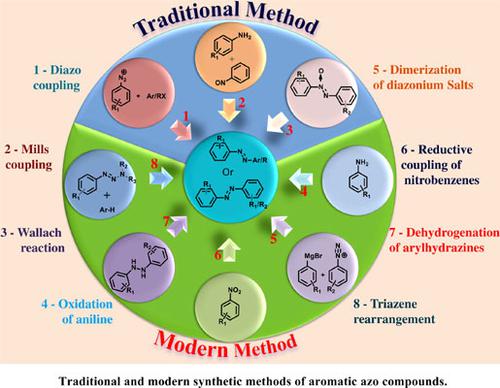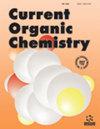A Review on Traditional and Modern Methods for the Synthesis of Aromatic Azo Compounds
IF 1.7
3区 化学
Q3 CHEMISTRY, ORGANIC
引用次数: 0
Abstract
Abstract: Aromatic azo compounds are “derivatives of diazene/diimide”, wherein the two hydrogens are substituted by phenyl groups. Azo compounds are very important universal scaffolds that show multiple applications in many areas of science, mainly chemical industries, where they are used in the synthesis of organic dyes, pigments, food additives, indicators, etc. They also remarkably exhibit various potential applications in the fields of pharmaceuticals, electronics, optics, etc., because of their fascinating photophysical properties. Moreover, several azo compounds have been strongly utilized as chemosensors, diagnostic probes, radical initiators, nanotubes, and building blocks of various polymers as well as natural products. This interesting and immense importance of the azo compounds has attracted the attention of researchers to establish novel synthetic routes to synthesize these important scaffolds. In organic chemistry, azo compounds can be synthesized by various methods utilizing coupling reactions with the aid of a catalyst or sometimes in the absence of it. The main purpose of writing this review was to provide a summary of the synthesis of both symmetric and asymmetric azobenzenes via various traditional and recently developed oxidative aza-coupling reactions.

芳香族偶氮化合物的传统与现代合成方法综述
摘要:芳香族偶氮化合物是“二氮/二亚胺的衍生物”,其中两个氢被苯基取代。偶氮化合物是一种非常重要的通用支架,在许多科学领域都有广泛的应用,主要是在化学工业中,它们被用于合成有机染料、色素、食品添加剂、指示剂等。由于其迷人的光物理性质,它们在制药、电子、光学等领域也表现出各种潜在的应用。此外,一些偶氮化合物已被广泛用作化学传感器、诊断探针、自由基引发剂、纳米管和各种聚合物以及天然产物的构建块。偶氮化合物的这种有趣和巨大的重要性引起了研究人员的注意,建立新的合成途径来合成这些重要的支架。在有机化学中,偶氮化合物可以通过各种方法合成,在催化剂的帮助下利用偶联反应,有时在没有催化剂的情况下。本文综述了各种传统的偶氮氧化偶氮偶联反应合成对称偶氮苯和不对称偶氮苯的研究进展。
本文章由计算机程序翻译,如有差异,请以英文原文为准。
求助全文
约1分钟内获得全文
求助全文
来源期刊

Current Organic Chemistry
化学-有机化学
CiteScore
3.70
自引率
7.70%
发文量
76
审稿时长
1 months
期刊介绍:
Current Organic Chemistry aims to provide in-depth/mini reviews on the current progress in various fields related to organic chemistry including bioorganic chemistry, organo-metallic chemistry, asymmetric synthesis, heterocyclic chemistry, natural product chemistry, catalytic and green chemistry, suitable aspects of medicinal chemistry and polymer chemistry, as well as analytical methods in organic chemistry. The frontier reviews provide the current state of knowledge in these fields and are written by chosen experts who are internationally known for their eminent research contributions. The Journal also accepts high quality research papers focusing on hot topics, highlights and letters besides thematic issues in these fields. Current Organic Chemistry should prove to be of great interest to organic chemists in academia and industry, who wish to keep abreast with recent developments in key fields of organic chemistry.
 求助内容:
求助内容: 应助结果提醒方式:
应助结果提醒方式:


